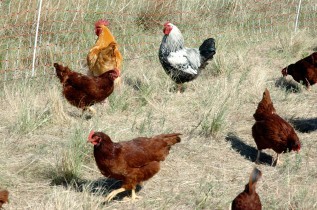Having dabbled in raising both meat chickens and layers, I’ve read my fair share of chicken books. Without a doubt, Harvey Ussery’s The Small-Scale Poultry Flock is the best book I’ve read about how to raise poultry in an all-natural way. Ussery not only discusses the usual ins and outs of animal husbandry, shelter, feed, butchering, etc. but he also discusses the critical piece of how to get the poultry to build soil fertility and integrate these important livestock in the garden. Given the need for livestock integration within cropping, this text is even more valuable by addressing this issue.
Of additional value is that Ussery has done the numbers and gives examples of what the net profit is for different types and sizes of poultry operations as well as marketing options. For example a scenario with 250 layers and eggs selling at $4.50/dozen with $13/hour labor costs at 10 hours of labor/week yields a net profit of $10,284 the first year and $12,827 the second and $13,327 the third with the sale of spent hens included. With the scenario of 2000 layers (still considered a small flock) with 30 hours/week of labor you have net profits of over $141,000. There’s nothing like numbers to get you thinking of the possibilities.
Besides the detailed spreadsheet examples, the appendices for this book include: instructions for making a mobile A-frame shelter and trap nests, a feed formulation spreadsheet for making your own feed, a comparison of nutrients between industrial eggs and pastured eggs, and a list of additional valuable resources. And also of great value are the numerous color-photographs on such critical instructions as how to butcher a chicken.
Because the focus of the book is on natural poultry raising, Ussery spends a considerable amount of space discussing key issues of avoiding predation and how to keep the poultry out in winter (two critical issues with pastured birds). Many books do not cover these topics or are not as clear in what can be done. Certainly Ussery speaks mostly from an East coast perspective, but his years of work with the American Pastured Poultry Producers Association, the American Livestock Breeds Conservancy, and the Society for the Preservation of Poultry Antiquities brings the lessons he has learned from many different regions to the fore in his writing (not to mention the writing he has done for Mother Earth News, Countryside & Small Stock Journal, and Backyard Poultry). Be prepared to challenge your paradigms of poultry management when you read this book. Of particular interest to me was Ussery’s decision to order straight runs of chicks because of the moral issue of euthanizing hundreds of thousands of cockerel chicks for the convenience of all-pullet chick orders. Likewise, for those who argue that you can’t integrate livestock and cropping, Ussery explains how he has accomplished this task in his garden space (or rather, spaces). By alternating which area the birds are and which are the crops are, he has an effective way to build organic matter while addressing concerns of pathogens. But his “chicken cruiser” that can work a raised bed definitely makes a variety of possibilities of integration possible. I don’t think I’ve read such a useful farming book in a long time. “Chookfull” of useful information and thoughtful commentary, this book is a must have for any poultry producer. Chelsea Green Publishing2011pp. 394

